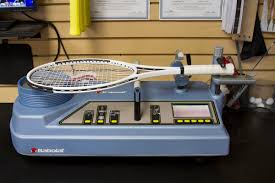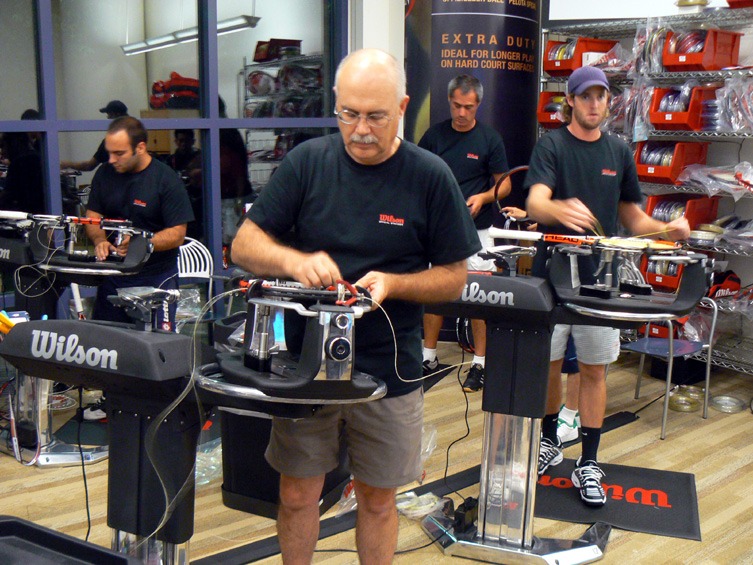Let’s talk about re-stringing…..Part 2 Revisited
In part one of this series, I talked about who you should trust for your racquet service needs and why. Dispelling the myth that your local teaching pro was the only person was the first step, while at the same time, clarifying that it’s not the teaching pro’s fault. Their organizations simply do not provide adequate training to prepare them when it comes to recommending racquets, strings, or the proper tension for a specific racquet and player. I should also point out that in the many years I’ve been offering training through the IART, we’ve had quite a few teaching pros who have taken it upon themselves to get some proper training to service racquets. Those pros are a rare breed indeed, and if you can find one, you’ll get the best of both worlds.
In this installment, I’d like to address the various things you can and should look for when you’re considering someone to service your racquet. In the United States, there are only two organizations that have ever offered any kind of training and or certification for racquet technicians. The training I mentioned in part 1, the IART training symposium (International Alliance of Racquet Technicians) that ran consecutively from 2007-2016, hosted a comprehensive training event for 10 years, and the USRSA. These two organizations focus on the art of racquet service and nothing else. They don’t teach you how to hit a better backhand, prepare mentally for a match, or anything about nutrition that might improve your game. Their focus is on racquet service…PERIOD.
The IART training symposium was the most comprehensive program anyone can go through that thoroughly prepared them for all aspects of racquet service. From basic stringing to high-level training that teaches the applicant to string on the pro tour, and anything in between. No other organization has ever provided that level of expertise and professional training.
The USRSA has traditionally focused on the fundamental basics of stringing, and they also provide certification programs. The certification tests require the applicant to take a written exam and to complete a hands-on test where they’re required to perform a few basic tasks that any racquet technician should be able to do. The combination of these two organizations has worked well in conjunction with one another over the last 10 years. There were multiple IART symposiums where I graciously offered space, stringing machines, and testers to the USRSA at no charge in order that they might offer their certification classes after the IART symposium classes had concluded.
So let me talk a little more in depth about the IART training symposium. This was the event that set the standard for education when it comes to racquet service because, before its introduction, there was nothing like it. The inaugural event was in 2007, and in 2016, the IART celebrated its 10th anniversary when Wilson Sporting Goods stepped up and hosted the event in Chicago. The important thing for consumers to know is that anyone who has attended one of these 5-day training events has acquired adequate skills and know-how to address the needs of any player at any level. If your technician has an IART training certificate hanging on their wall, you know you’ve come to the right place.
These techs will address three key areas of your game:
- Racquet selection/recommendation
- String selection
- Tension recommendation
All of the above would include:
- Consideration of your personal playing level
- Type or style of play, ie, baseline, serve/volley, or all court
- Any health issues the player may have, such as tennis elbow, etc.
Each of the above-mentioned categories requires the technician to have a one-on-one conversation with the player in order to do a thorough analysis. Once that’s done, the two of you will begin to work together to find the very best racquet to match your personal playing style and level of play. After the racquet has been found, it’s time to think about string and tension, and with the vast abundance of string to choose from, you’ll appreciate having a trained technician by your side who can slow-walk you through the process.
Why is all of this important? For starters, all players have a set of numbers, and these numbers correlate to your style and level of play. The numbers come from a series of tests performed on professional-grade equipment that a qualified technician has invested in. This could be a Babolat RDC or other similar equipment that is specifically designed to ascertain the necessary information the technician needs.

Once you have these specs, you should keep them tucked away in your bag. They’re yours and yours alone, and until you’re ready to change racquets, your specs are invaluable. They can be used to match your racquets if you have more than one of the same brand/model, and they’re also valuable in helping you when it comes time to select a new racquet. Keep in mind too, that as you advance in play that these specs undoubtedly will need to be changed, which is another good reason to find a good technician to work with. For example, if you’re a NTRP 3.0-rated player and you’re serious about your tennis, eventually, through lessons and playing experience, your game is going to improve. When that happens, you’re going to need a completely different racquet to complement your improved game. Beginners often do better with a lighter, oversized racquet and one that is head-heavy (overall weight is balanced more towards the top of the racquet). These are sometimes referred to as “Game Improvement” racquets. This is because beginners often have short, compact strokes, and these racquets are better suited to that style of striking the ball. However, as your game improves and you begin to take a full swing as opposed to a compact swing, you’ll find that you’ll have more balls going long and landing over the baseline. At that point, control becomes increasingly harder, and you’ll need to find a solution. Keep this in mind because it’s extremely important—you do not adjust your stroke to the racquet; you adjust your racquet to the stroke. You’ve spent countless hours taking lessons and improving your game to learn the right way to hit every shot. Why then, as you improve and spend your hard-earned money on lessons, would you change your stroking technique to accommodate a racquet that is ill-suited for the progress you’ve made? This is not racquet science, but you would be amazed at just how many people don’t realize this, and it’s one of the most basic norms that a trained racquet technician follows.
In summary, remember to seek out a trained racquet technician when you need advice on racquets, string & tension. You can go HERE to see a list of IART technicians that are properly trained to help you, and once you start working with a trained tech, you’ll soon discover exactly what I’m talking about.
Go HERE to see part 1
Go HERE to see part 3


Leave a Reply
You must be logged in to post a comment.